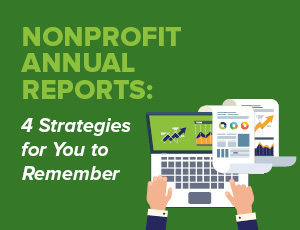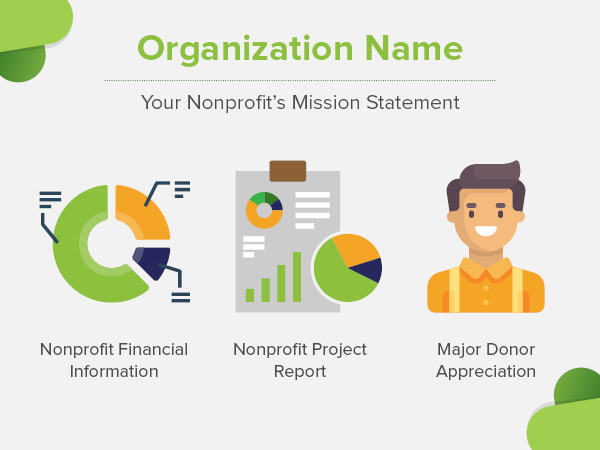
Your nonprofit accomplishes a lot in the course of a year. Telling your supporters about these accomplishments and the impact of their contributions is a great way to express your gratitude and to show them the value of their support.
Your annual report is one of the most effective methods to communicate the story of the impact of their gifts. This document gives you the opportunity to provide donors with the financial information for the year and tell them what those finances accomplished.
This year, nonprofit annual reports are especially important. Expressing to supporters the steps that you took during the COVID-19 pandemic to keep doors open and continue serving your constituents will be vital information to communicate. This will likely make up a substantial portion of your report.
Too many nonprofits fail to make the most of their annual reports each year. These resources are a great way to increase trust and transparency among supporters.
In order to ensure your nonprofit crafts an awesome and effective nonprofit annual report this year, we recommend the following strategies:
- Include vital annual report data.
- Pick a smart reporting platform.
- Don’t exclude financial data.
- Discuss your nonprofit’s projects.
Ready to learn more about annual reports and how to help yours succeed? Let’s dive deeper!

1. Include vital annual report data.
Every year, your nonprofit needs to report on your financial standing and other organizational information through your Form 990. Because these forms are publicly available, nonprofit supporters and donors can access this information to learn more about your organization’s overhead and leadership.
However, the annual nonprofit tax forms don’t provide adequate space for explaining projects, campaigns, and other measures of success. Therefore, crafting your own annual report in addition to the official form is an important measure to take for effective and complete communication with supporters.
As you can see in the image below, the ingredients that make up the recipe for an effective annual report include your organization’s mission, financial information, project reports, and major donor appreciation.

But what does this actually look like?
Your organization’s name and mission statement are standard elements to include in your annual report. They’re unchanging and easily added. However, the other ingredients to the winning recipe might seem a little more confusing. Here’s how we recommend including vital information:
- Nonprofit financial information. Tell supporters exactly what they want to know. It’s a good idea to make the information readily available and easy to read. A simple pie chart visually expresses your overhead expenses compared to program costs. Break down your overhead by operational expenses, fundraising expenses, and other expenses for additional explanation. Similarly, break down your programming costs by specific projects and initiatives.
- Nonprofit project report. Let supporters know about the specific projects and programs you’ve accomplished or are working towards. This acts as a progress report so that supporters aren’t left in the dark about the campaigns they’ve been part of. For example, if you started a program to tutor underprivileged kids at a local elementary school, tell supporters when the program launched, how many kids you’re helping, and results you’ve seen from the tutoring program. Or, if you’ve launched a capital campaign, tell supporters how close you are to reaching your goal.
- Major donor appreciation. Your annual report is a perfect place to give a shout out to your major donors. It allows your entire community of supporters to recognize the major efforts, which helps communicate your gratitude publicly. Consider conducting a small interview of a particular major supporter to dive deeper into their motivations to give, the campaigns they’ve supported, and their personal connections to your nonprofit. Be sure to save this donor information in that donor’s profile within your CRM so that you can reference it later.
As mentioned earlier, this year’s report will likely also include information about COVID-19 and the actions that your nonprofit took to ensure safety and continue operations. While this isn’t a usual section that you would include, it’s important to mention that extreme external circumstances, such as the global pandemic, should not be ignored in your annual report. This is especially true if the external circumstances had a direct impact on your regular activities.
Your annual report is an incredible opportunity for your nonprofit to express a comprehensive review of your annual activities. Be sure to clearly express the data that supporters want to see and to use the communication platform strategically.

2. Pick a smart reporting platform.
As nonprofit software and technology have advanced over time, so has our potential for creative annual reporting.
Annual reports used to primarily be in a physical book format that was sent out to all (or a select group of) supporters through direct mail. Not only is this expensive, but not all of your supporters are likely to find this format engaging. They may lose focus partway through and never absorb all of the information you’ve included.
That’s why we recommend choosing a platform (or a couple of platforms) that your supporters are more likely to engage with. Plus, this is a great opportunity to save some additional funds.
Some of the platforms that your nonprofit might consider for your annual report include:
- Classic book. Many of your supporters, particularly your more traditional ones, will still prefer receiving a book format of your annual report. Consider, also, sending this book to offices and places where prospective supporters may come across it and start reading, such as doctor and dentist offices.
- Online PDF. If you use the book format for your annual report, we also recommend you create an online version of the publication as a PDF. The well-designed report can be published on your website and emailed out to your supporters. This saves money that would have otherwise been spent on additional printing and mailing of report booklets.
- Video. If you’re feeling especially creative, you may consider publishing your annual report in a video format. This is a highly engaging format that draws in your supporters and engages them with minimal effort on their part. However, if you decide to film a video, keep in mind that you’ll need a high-quality video camera and a well-practiced editor to make sure the report is professional looking.
- Postcard or self-mailer. Postcards and self-mailers are great if your audience prefers direct mail, but may not want to page through an entire book. These are condensed versions of your annual report that highlights the most sought-after information for supporters. If you go this route, we recommend that you also post a full-length report online and direct supporters to it within the direct mail if they’re looking for additional information.
Survey your supporters to ask them which annual report format they’d prefer. Save this information in your donor database and create specific segments for each response so that you know how to best communicate the information to them. Bloomerang’s donor database guide explains how you can use your donor profiles and segmentation strategies in situations like this.

3. Don’t exclude financial data.
One of the fatal flaws that nonprofits run into for their annual report is excluding key financial data. If you had a fundraising campaign that didn’t hit its goal or a project that was more expensive than anticipated, it can be tempting to try to cover up these little blunders.
However, if you exclude financial information from your annual report, your nonprofit risks coming across as insincere, nontransparent, and untrustworthy.
Make sure to include all relevant financial information in your annual report, whether it’s good or bad at first glance. If you do have a few blunders from the year, you can use your annual report to communicate some additional context that will ease donors’ minds about the situation. Some of our favorite strategies to add context include:
- Explain what went wrong. Sometimes, there are things outside of our control that impact goals and plans. For example, your capital campaign may have been put on hold with the downturn of the economic climate. Explaining that the economic crisis forced you to postpone plans is a justification that supporters will understand.
- Tell donors how you handled the situation. Explain to your donors the remedial actions you took the moment that things started going wrong. To use the capital campaign example again, you may have lined up calls with your major supporters to confirm their continued interest in the campaign. This can act as an expanded feasibility study but would also help ensure a successful campaign when it is launched.
- Express how things will be different in the future. This simply shows donors that you’re always learning as an organization. If you’ve postponed your capital campaign this year, you may decide to include a contingency plan for future campaigns, explaining how you’d handle unexpected situations and stay on track. Tell donors about the progress of this plan and how it will help handle similar problems in the future.
To confirm you don’t leave something out of the report by mistake, talk to your accountant to make sure you’ve collected all relevant information that you should include.
Jitasa’s review of working with a nonprofit accountant explains how your financial expert goes over your accounts to catch incorrect information and makes sure everything is complete on the financial side of things. Working with this individual for your annual report can also ensure the data you communicate is accurate and complete.

4. Discuss your nonprofit’s projects.
When you talk about your nonprofit’s projects in your annual report, this is an opportunity to brag about everything you’ve accomplished. Compare the information for your annual report to your nonprofit’s strategic plan (a guide for which you can find here). This will show you what you planned vs. what you accomplished during this year.
While your strategic plan may not be public knowledge, it’s always good to have a comparison point for your own team’s analysis. It can also remind you of the various activities you completed earlier in the year, which may have escaped your mind at the end of the year.
When you talk about your nonprofit’s various projects and programming activities, be sure to:
- Explain exactly what the program does. Be specific in what the program or project is as well as how it does. How many people are impacted? Is there a specific story of an individual you can draw on? Process and impact are key elements to include in your explanation.
- Talk about how it relates to your mission. Relate everything back to your mission. Even if it seems obvious how the project connects to your overall mission, reiterate the point for your readers. This ensures they keep your mission at the center of their attention while they read.
- Communicate plans for the future. Tell supporters how you plan to keep the program going and continue making it better for the future. This reminds them that the job of your organization is never done. It also gives them an actionable “next step” to keep contributing to that particular project in the future for your nonprofit’s continued success and growth.
When you talk about your projects, make sure to put it in terms that further congratulate your supporters for their help. Saying things like, “Your generous contribution helped provide 100 children with backpacks for the upcoming school year” shows donors the impact of their dollars. After all, you couldn’t run many of your successful programs without their help and funding!
Nonprofit annual reports are incredible opportunities for organizations to express their successes, provide context for blunders, and to show their donors that they care. These tips are the first step to ensuring your report is as successful as possible. Good luck!
- Conduct research in your donor database to decide what annual report format is best for your organization.
- Check out the links throughout this article to complete additional research and start planning for your annual report.